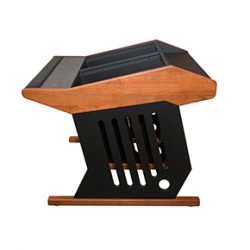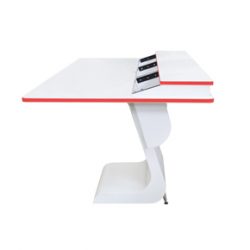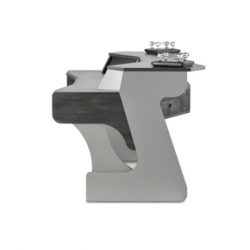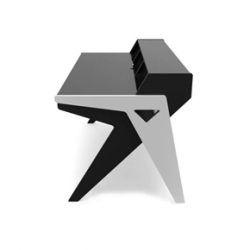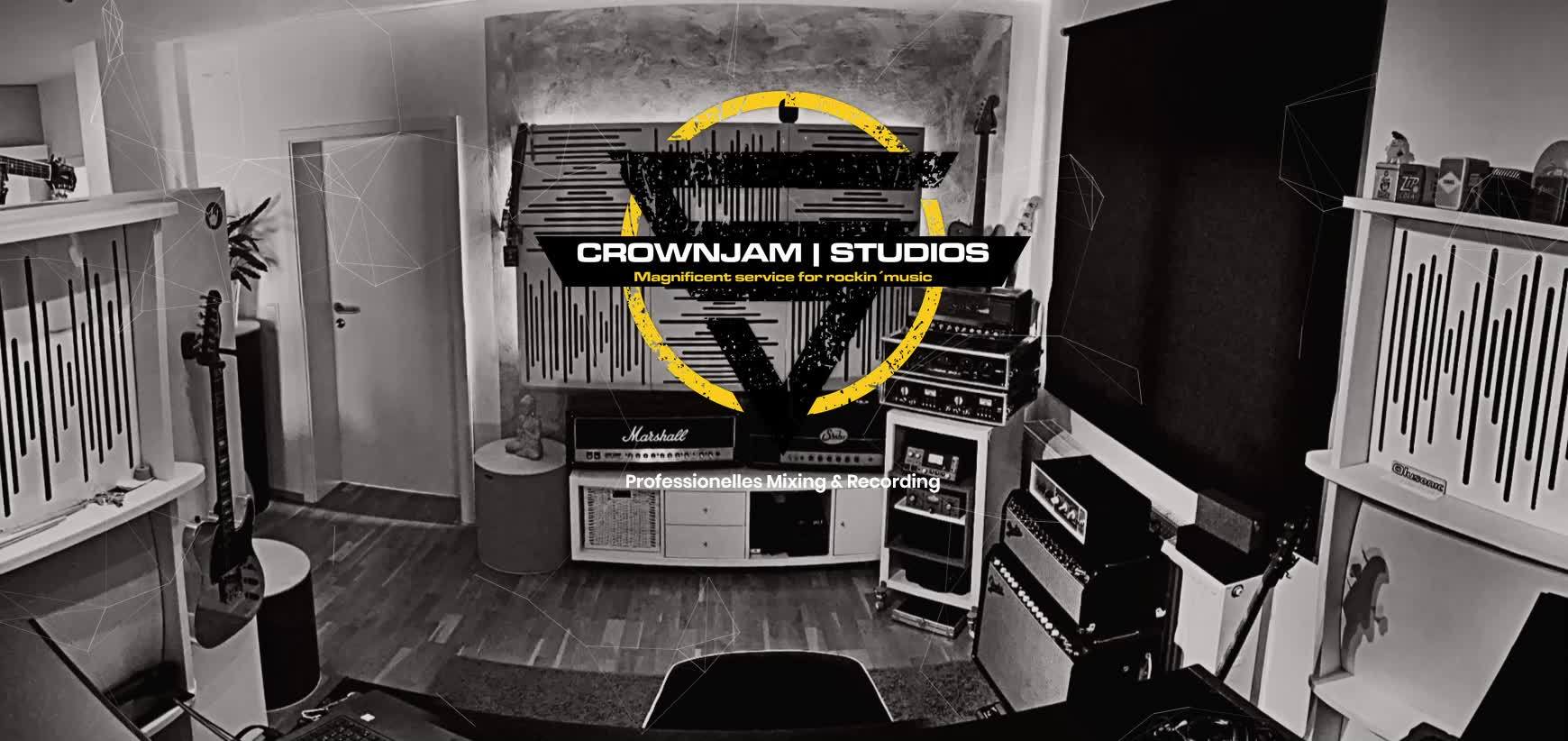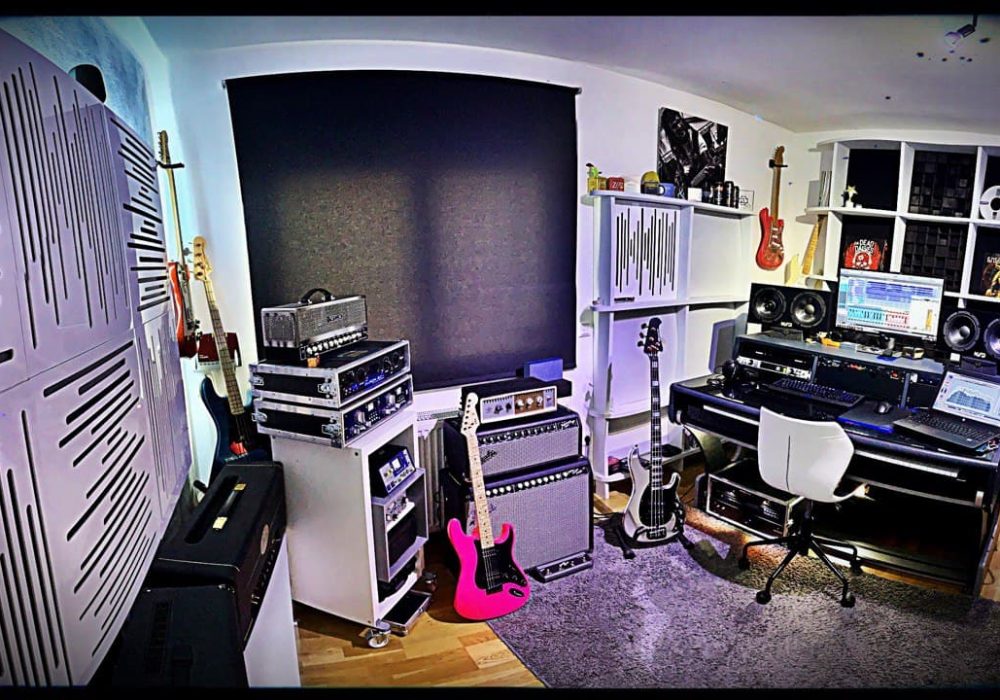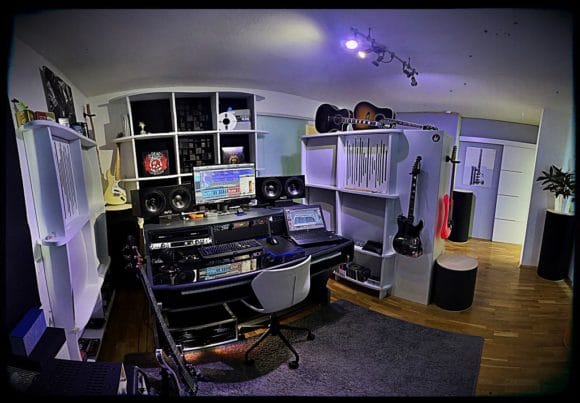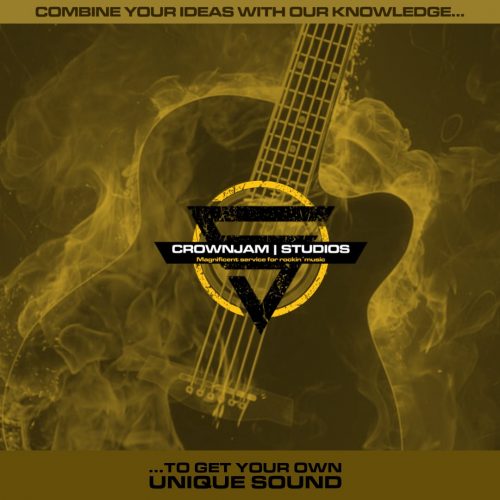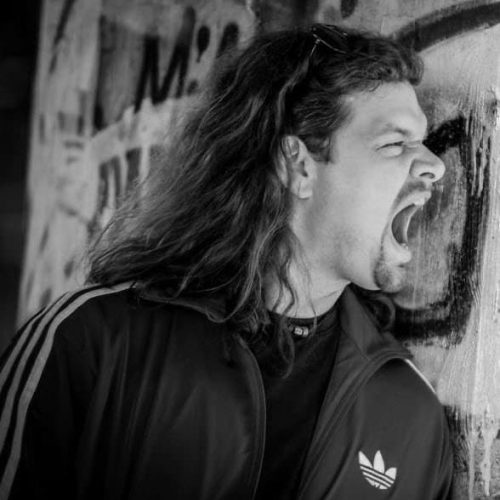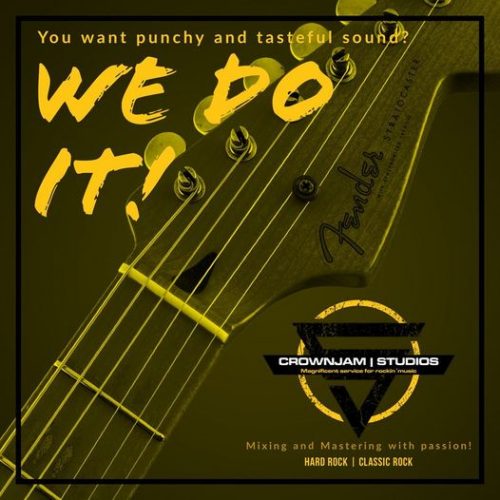Intriguing studio locations, numerous participants, and countless captivating photos of Zaor products in practical use – our Studio of the Month campaign was an impressive showcase for the versatility offered by Zaor studio furniture. The winner of the big draw has also been determined: Claudio Jans. With his CROWNJAM | STUDIOS, the producer and mixing engineer primarily caters to the hard-rocking faction of guitar-loving music fans. We took the opportunity for an interview about his career, his studio and his way of working.
Your studio is already equipped with Zaor furniture. How do you use your prize?
Claudio Jans: I am going to replace my current Zaor desk with a newer and bigger model. I currently use a Miza 88 XL and am already looking forward to my Miza X2 Flex special edition with a white finish – which is a better fit for my corporate design. I also really needed a solution for all the Marshall amps and mic pres that are currently set up behind me. The latter are built into cases as I frequently take them with me on the road. In talking with Zaor we came up with a customised solution I can simply slide these cases into. This way, I can use the preamps in the studio and just pull out the cases when I want to travel with them. Basically, my studio is getting completely refurnished with custom-made solutions. I am super excited!
Let us talk about your career path. How did you get into music?
Claudio Jans: I started playing music at an early age – I was eight or ten years old. It all began rather conventional with guitar lessons and strumming at the campfire during my time with the boy scouts. I wasn’t aware of Rock’n’roll back then, but I had seen older boys with those strange electric guitars. Music continuously fascinated me, and one thing led to the next. I continued my lessons, did a lot of autodidactic learning, and then started to play in my first band. That really got the ball rolling.
That sounds like a proper old-school path.
Claudio Jans: Exactly. Music always played an important role at home, too. My father has a huge record collection, which I only learned to appreciate later.
Music continued to be an integral part of your life?
Claudio Jans: I was enthralled when I started to attach my identity with music. It was an important way to express my personality. I was basically destined to turn professional at some point.
Your career path then led you to music production.
Claudio Jans: That happened very early on. I was part of the music club at my school where we had access to a TASCAM 238 eight-track cassette recorder – which we were allowed to take home sometimes. I started to experiment: “Ah, ok, I need a mixer to record something – but how can I hear anything? Ah, okay, I need a second mixer” … I was so fascinated by the learning experience that I soon bought the book “Home Recording” by Peter Bursch. It is an excellent book for beginners because everything is explained clearly and from the beginning. That was 25 or 30 years ago.
What were your first recordings?
Claudio Jans: We started taping our first demos, began experimenting with the computer and needed recordings for our own band. We were constantly looking for a studio – but those were rare and far too expensive for a student band. So, we took our first steps with the eight-track machine. I still have the old master tapes from back then.
Really?
Claudio Jans: Sounds crazy, doesn’t it? But we managed to put a demo together, somehow. When the guys turned 18, most of them wanted a car or something similar. I, on the other hand, drafted some kind of preschool-level business plan to get a loan for a recording studio. I was able to afford the basic equipment and get started. Everything was analogue back then, with a 16-track tape machine and rather cheap peripherals. But we managed to put a decent demo together and other musicians wanted to record at my studio, so I managed to refinance my investments. That is how I got into producing.
Wow. It is rather unusual to follow this path so consistently from the age of 18.
Claudio Jans: It is, but it pays off. I also had a large network of musicians, which really helped me early on. I originally come from Mönchengladbach and was lucky enough to meet Charlie Terstappen alias Charlie T. – he used to play the drums for [very popular German pop/rock singer] Marius Müller-Westernhagen and had his own studio. I learned a lot while working with him, because he focused on securing the right “feeling” and setting the stage rather than on setting the compressor. When a singer wants to evoke emotions, well, then put 300 candles all around him if it helps! Those were valuable lessons, and I kept trying to get a taste of many different musical aspects. I went to SAE, to the HOFA College, and took courses everywhere. I am convinced that you never stop learning. There is always something new somewhere.
Are you still focusing on the right feeling for the musicians or has your approach changed?
Claudio Jans: The tasks are distributed somewhat differently these days. Back then, I used to be responsible for the whole production from start to finish. These days, musicians tend to record themselves, if only for cost reasons. And that’s ok. I usually try to get involved early on and support the artists in establishing the right conditions to achieve the best results. This is where I point out to them how important it is to be in the right mood. If, for example, the guitarist needs 300 tons of delay to perform his solo, then just let him have it – simply leave it out of the recording. I still enjoy working in actual recording environments, though. For cost reasons, they usually only involve drum recordings, as those often prove to be quite challenging in my genre. In general, drums and vocals are still being recorded at the studio, while guitarists and bassists work from home with whatever tools they feel comfortable with.
You started with an analogue studio. Do you still benefit from this experience?
Claudio Jans: Having that background in the analogue space is a huge benefit for me. Being limited to 24 tracks helps to focus on the essentials. You could say that I still work as if I was recording on a tape machine – with added digital benefits. My first studio in Mönchengladbach had dedicated recording rooms and an actual control room with a huge mixing console, an Allen&Heath Sigma 24L24. Then there was a 2-inch 24-track machine, a Telefunken M15A as well as the whole MIDI synchronization spiel. Later, the DAWs basically replaced the sampler, and ultimately, I had a setup with a DAW as well as a tape machine. At that point, a lot of folks went with the DAW, if only because of the exorbitant tape costs. This led to a decrease in tape manufacturers – I think there is currently only one left. Trying to explain to a band that 15 minutes of recording will cost them 350 euros simply won’t fly anymore. Although we are seeing a renaissance right now – people want to record on analogue tape again.
What does your studio look like these days?
Claudio Jans: I gave away my analogue equipment when I relocated. The digital equipment was advanced enough for me to make the switch. My current studio consists of just one acoustically perfect room that I use for mixing and mastering. This saves me a lot of money compared to a big studio. I am well connected and have access to studios from my peers, should I need them. I can record in their studios and then return to my mixing lounge. In addition, nowadays a lot of tracks are delivered online, leaving me with just the mixing situation.
You are running a pure mixing studio?
Claudio Jans: My studio is a pure mixing studio, but I have a recording system that’s fully mobile. Leftovers from the analogue era, like microphones and a lot of preamps, that I take with me. I don’t necessarily need a sound studio to record. I use a neat DiGiGrid system that seems to be somewhat uncommon here. It provides a flexible network solution and great converters. Apart from that, all I need to bring is a notebook and two or three cases. With microphones, mic stands, and cables, we could record in your living room if that’s what you wanted. It’s great.
So, you have a mixing studio and a mobile recording setup. But you list four locations on your website …
Claudio Jans: Exactly – those are my colleagues I work with most often. Obviously, it’s important where the band I’m working with is located. Due to my online offering, some bands are not even from Germany, which complicates the recording process. These bands usually take care of that part by themselves. But when I am recording, I like to use go to Streetlife Studio in Fürth. With around 200 to 300 square meters, it’s Europe’s best recording room as far as I am concerned. There also are various levels, so you can put the drummer in a place where the snare develops the most pressure on the room mics. That is something that is missing in a lot of recording places these days. Rock and hard rock are my jam, and simply need room mics to get the proper impact. That is why Streetlife is such a perfect recording studio for me. I also work as lecturer at the HOFA College every now and then, giving me access to the HOFA studios in Karlsdorf. The Klangkantine in Darmstadt is another cool studio. Basically, I am where the band needs me to be – and Aschaffenburg is my home base. There’s also another associate of mine here wo runs the “Beat & Breakfast”. It is not so much a studio as it is an entire acoustically upgraded house that bands can rent for a weekend.
Which services do you provide for your customers?
Claudio Jans: The focus is on mixing, mastering, and recording. Also, the complete production from start to finish, if desired. But I am not doing all the work myself. We have established a network of associates for close collaboration. Basically, I help a band to reach its goal – whether that is a demo or releasing a damn cool record and make it big. Then we look at what we need to reach that goal. That is what I do. My associate and good friend Gundy Keller lives only 15 minutes away from me. He was a famous guitarist in the 80s and 90s and contributed to all those awesome guitar effects with Boss and Roland. If bands want proper guitar and bass sounds, I send them to Gundy. I then mix what they produce and pass it on to the mastering engineer so we can get the perfect result. It would be possible to do all that with just one person – but I am convinced the result would be suboptimal. I also consult the bands on topics such as: what do we need to do in order to attract attention in today’s social media landscape?
You do that as well?
Claudio Jans: Absolutely, but not on my own. That is Tobias Rauscher’s expertise, who runs the Fanbase Academy. However, bands need to be willing to do the necessary editorial work themselves. We provide the tools and strategies. A lot has changed in the musical landscape. These days, you usually do not start with an album, but rather with various singles that are compiled into an album later. You need to release a lot of content – ideally including videos. Tobias trains bands on the necessary tools to publish and push those videos so that they attract attention. We are talking about the complete advertising package, basically. On request, we will also put bands in touch with suitable record labels – but self-promotion is much more common these days.
Your main area of expertise seems to be mixing. Do you specialize in certain genres or are you open for anything?
Claudio Jans: I am very much specialised. I am a true rocker at heart and feel right at home with hard rock or classic rock. But that does not mean that I would turn down Blues music. It is probably more accurate to phrase it differently: I do anything related to guitar music – including acoustic projects, which I also enjoy. My passion, however, is that classic rock moment when an amp is turned all the way up, and someone gives his drums a proper beating. That’s what I live for.
Moments where you can truly hear air in motion – be it from the drumhead or the loudspeaker.
Claudio Jans: Exactly. I also support bands in live environments – but that has less to do with the studio and more with me as a person. I worked with the Lords for three years, in the studio as well as on tour. Another important achievement is the collaboration with Charlie Terstappen I mentioned earlier. My productions won the German Rock+Pop Award [Deutscher Rock+Pop Preis] three times already. Then there was some American Talent thingy. And now I even won a raffle! (laughing)
Which was your biggest career jump, of course.
Claudio Jans: Obviously. (laughing) The band STINGER is a regular customer. I am currently producing their fourth album and regularly accompany them on live gigs. Those are always something special, because we play events like Wacken, the Baltic Open Air and other big festivals. STINGER is well connected within the industry. In addition, there have been some collaborations with famous artists such as Mark Evans – a former bassist for AC/DC who is now part of Rose Tattoo. I once recorded him in his hotel suite in Berlin. I also had the pleasure to record people like Simon Wright, Bob Richards, Luca Princiotta, Chris Laut or Dai Pritchard. A new collaboration with a famous artist is currently in the works, but that is all I am allowed to say at this point …
What does your studio look like? You probably use exactly that one room?
Claudio Jans: Correct. It is an acoustically optimized room with a Zaor table that is about to be replaced by a shiny new model. I mix exclusively in-the-box and am also paying attention to capture this “mojo” in the recording stage of a project. Or I try to relate it to the bands that record themselves. I tend to let guitarists and bassists play via DI box. I encourage them to use their amp and any other equipment they need to play comfortably – bringing us back to the importance of the right “feeling” we talked about earlier. I then take the DI track, check the storage and re-amp with fitting amps. That’s when I get to play with all of my cool toys.
You re-record the amp sounds in the mixing stage?
Claudio Jans: Yes. Plug-ins are all right, and there are really good ones that I also use. But I usually work with my amp. I am familiar with my mics and my preamps, so I know exactly what to expect.
There is a difference between air moving in front of a microphone and a signal that is generated or processed digitally.
Claudio Jans: Exactly. One mic to the speaker, a second one in the room. I always use a combination of multiple microphones to achieve the level of malleability I require. That’s where my 25 years of experience come into play. The right speaker and the right microphone preamp combination – that makes it Rock’n’roll.
Do you have a “winning team” of microphones or do you decide on the spot?
Claudio Jans: It depends, really, but I usually end up using the same “winning teams”. Like, a Plexi and a Vintage 30 speaker, then an SM57 straight to the cabinet, going through a Chandler TG2 preamp. That’s the main sound, pure Rock’n’roll. Additionally, I often have a large-diaphragm microphone in front of the speaker. At the moment I am completely in love with the LEWITT microphones. They have this LCT 440 Pure, that sounds amazing at that point. I might throw in a room mic, as well – depending on what I want to achieve, that could be a ribbon mic or something else. And then you need fitting preamps.
Do you use other preamps? The Chandler TG2 has a very particular character, after all.
Claudio Jans: That’s true. And it is exactly the reason why I kept all the preamps. A preamplifier can change a lot in the sound – if it is one that does add character, that is. There are a lot that just sound nice, without adding much. I use my DiGiGrid converters, they are extremely clean, so I don’t need that from the preamps, too. I only use mic pres that add a touch of their own. Like the TG2, it really sounds very special. I also have the Chandler Little Devil, a really cool preamp. Or the MM-1 by Black Box that lets you mix pentode and triode, resulting in raging harmonics – or none. Quite a wide range of colours there. I also have that old DBX 786, from the Blue line, if anyone remembers that. That thing has a great treble boost around 40 kHz. Not useful for guitars, but for vocals or room mics. A boost there results in a very subtle, smooth accent in the high frequencies.
It adds breath.
Claudio Jans: Exactly, that special wisp that you cannot replicate with a simple EQ. It is somewhat similar to a Pultec EQ – they also boost frequencies no human can hear, but something from that boost affects the spectrum below, and that’s the magic.
Let’s talk about your monitoring. What speakers and headphones do you use?
Claudio Jans: I have KSD C88 Reference.
Not a bad choice!
Claudio Jans: You can get worse, and you can get better, but that is not a topic for me. It doesn’t really matter what speakers you use, you just need to be able to work with them. I have tried a lot, and this setup reproduces the sound the way I need it. I have experimented with smaller speakers and subwoofers, but I was never satisfied with that. The KSDs reach far enough into the lows that I enjoy working with them. Sometimes I also check on my IK Multimedia MTM – they come with a carry bag, so I always have them with me when I travel.
They have a reputation for sounding great, considering their size.
Claudio Jans: They do indeed. It’s incredible what amount of sound you can get out of them. They are not incredibly loud, but they can project a surprising amount of bass. The stereo image is not great, but they are perfect for judging sounds when you’re out and about. Plus, they sound notably different from the KSDs, so they sort of replace the kitchen radio monitoring – even though they actually sound far too good for that. (laughing) I also use a Beyerdynamic DT 1990 for reference. With this set of headphones and the KSDs, I can mix everything and it will translate. I still do cross-reference in the car or through my daughter’s Bluetooth speakers. And I listen to my mixes on my iPhone – that’s the reality of music consumption today. Hifi freaks are rare, a lot of people just listen on their phones.
Are you using small in-ears or the phone’s speaker?
Claudio Jans: Both. I always double-check my work and sometimes find problems that need fixing. But I generally manage to make mixes work just with my monitoring system.
You probably know you room well enough to have your mixes translate.
Claudio Jans: Yeah, it’s more cases like a bass drum that hits hard in the studio and then disappears on the phone. You don’t have low frequencies there, so you need to place a part of the kick in the higher spectrum without destroying the mix. That is why I double-check with the phone.
How much do you usually have to edit when bands send in their own recordings?
Claudio Jans: That depends on the band. I generally expect takes and recordings that don’t require a lot of editing, and I generally tell the bands how to get to that point. If they ask me to edit, I do, of course, provide this service to the necessary extent. For example, I sometimes take their drum tracks and try to shape them so they can go on working with them. Often, edits are not really needed since the bands know that it will cost them money. They then prepare accordingly and deliver solid takes.
Were bands better prepared for recordings when tape was still widely used and hence redoing every take dozens of times was not an option?
Claudio Jans: Yes. I don’t know whether that changed for individual musicians, but you used to have bands playing so tightly together you could just record them live. That was a fundamentally different performance. They had this special groove from playing together, and would often run into problems when they were asked to overdub. Today, productions tend to adhere to the grid, which seems to lead to musicians recording mediocre performances and then editing it to perfection. The possibilities with today’s tech are incredible. I do like that, but more in the sense of improving an already great recording.
When you cut up the entire take and lock everything to the grid, you don’t really get any feeling anymore.
Claudio Jans: It does depend on the genre and style a lot. In harsher genres you can probably measure the beats with a ruler. Those productions are often so polished that all character is gone. I currently enjoy the band Dirty Honey a lot, a relatively new outfit from the USA. They just sound like … “okay, count in, let’s rock!” But of course, this is all a question of personal taste, and also a generational thing. What they’re doing today is not wrong, it’s just different from how we used to work. Look at guitars, for example: everybody is in love with amp simulations today. Great tools, but very far removed from a guitar with a valve amp. I can work with that, I can feel that. But guitarists today grew up with simulations and are often unfamiliar with this special feeling, so they don’t miss it. I recall a recording situation with STINGER when the lead guitarist wanted to quickly record a take. He used a simulation, but he didn’t feel well with it and you could tell from his performance. So we threw away that take and gave him a vale amp. The feeling was there, instantly, and his entire performance changed. However, I don’t think that valve amps are the better choice in general. Chances are that if you give one of those to a young guitarist, they might get scared. (laughing)
I know what you mean.
Claudio Jans: It’s the same with recording. That has changed completely. Nowadays, everyone can buy studio equipment from a large retailer for comparatively small money, and start producing to a certain degree. It does kind of work and may even progress further. But there will always be the few standing out, the ones who understand what it’s really about. There is nothing wrong with bands making good use of these possibilities to write and refine their material. But when you want to go the next step, you come to the point where you need to stand out. That’s when you should rely on experience and look for appropriate help. A lot of bands struggle with that – it’s hard to give away responsibility like that. No one likes to share their toys. (laughing)
Very true. Very true indeed.
Claudio Jans: It is totally worth it, though. For example, I would never master a track that I have mixed myself. Even when I am organising the entire chain, I will give the material away to an external mastering engineer, because I want a second pair of ears, their unrelated expertise. I have a great network of people and know where to send a production to get perfect results.
What is next for Claudio Jans and CROWNJAM?
Claudio Jans: I hope it keeps going as it does. I can’t complain about lack of work in this pandemic, even though there was a slight downturn in the beginning. The bands were considering what to do and if recording would pay off in this situation. But I am always networking and looking for new fields of activity. I currently work with ProArte, a music distributor, on a presentation room and shows. They use streaming and video to present great musicians and their performances. [Renowned singer] Andreas Kümmert was there recently, for example. I completely equipped that room, using my connections; for example, they have a DiGiGrid system now, too. I am also currently speaking with Spanish manufacturer Tierra Audio. They build microphone preamps and compressors, all analogue, that is something we want to get into the ProArte room as well. So we are quite busy expanding that distribution side of things. The question is, what will happen with the live business. A lot has collapsed, many shows were cancelled. Let’s see where this is going – you never know how people will accept it once the pandemic is over. I am curious to see what’s going to happen. And I am still waiting for that number one hit, of course. (laughing)
With your new furniture it is bound to happen!
Claudio Jans: It has to! (laughing)
